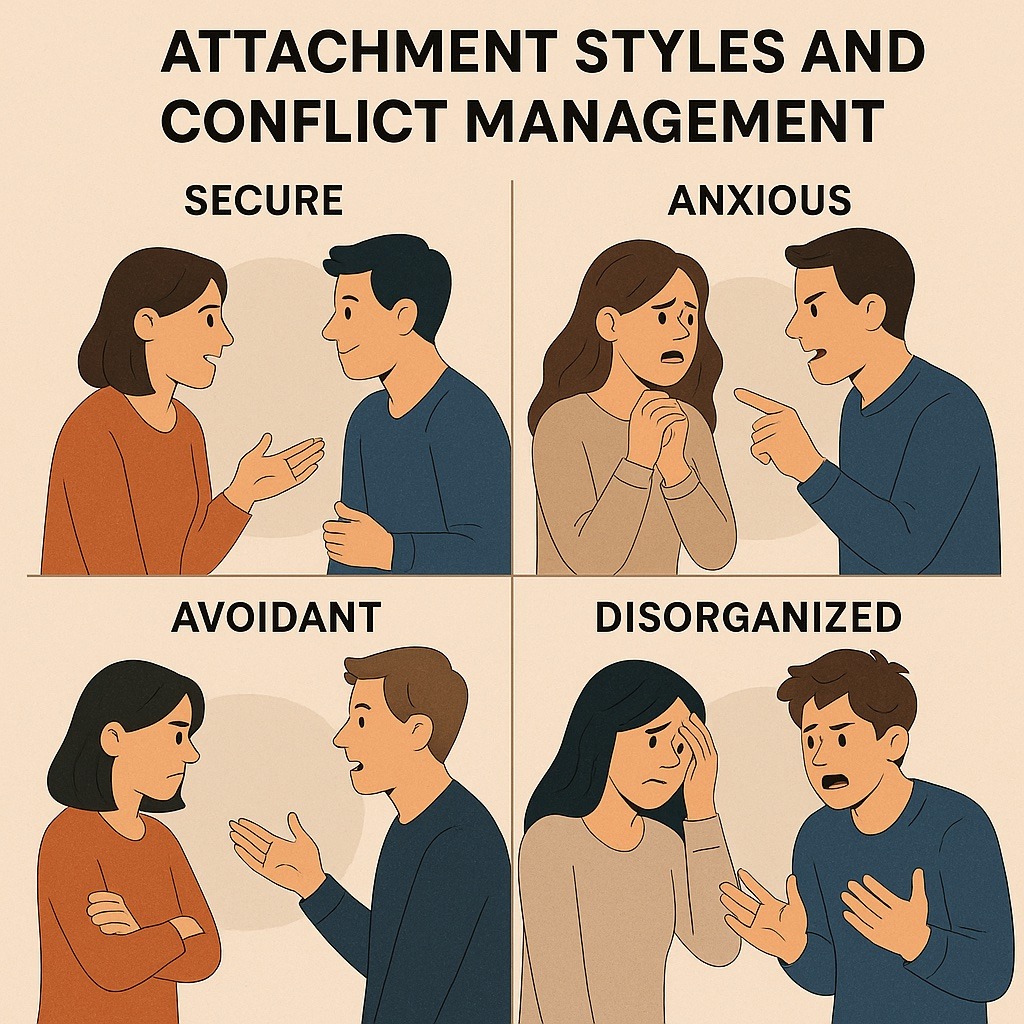Attachment Styles and Conflict Management: A Psychological Perspective

🎯 Introduction: Who Should Read This and Why It Matters
This article is for mental health professionals, relationship counsellors, mediators, and individuals interested in understanding the dynamics of interpersonal relationships. We will explore how different attachment styles secure, anxious, avoidant, and disorganized influence conflict behaviours and resolution strategies.
Understanding these attachment patterns is not only vital for emotional well-being but is also a cornerstone of effective conflict management. Conflict is an inevitable part of any close relationship, and how individuals respond to it is often deeply rooted in their early attachment experiences. By examining these psychological foundations, we aim to provide insights that enhance communication, emotional resilience, and constructive resolution of interpersonal tensions.
📚 Foundations of Attachment Theory: The Psychological Blueprint for Relationships
Attachment theory, developed by British psychoanalyst John Bowlby in the mid-20th century, serves as a cornerstone of developmental psychology and has profound implications for how individuals form and manage relationships throughout their lives. Bowlby’s foundational assertion was that the bonds formed between infants and their primary caregivers play a critical role in shaping emotional and social development.
Bowlby emphasized the biological and evolutionary basis of attachment, proposing that humans are born with an innate system that drives them to seek closeness to caregivers in order to survive. This “attachment behavioural system” becomes activated in times of perceived threat or distress. Through consistent, responsive caregiving, a child develops a sense of “secure base”, enabling exploration of the world while maintaining confidence in caregiver availability.
Building upon Bowlby’s theoretical framework, Mary Ainsworth, a developmental psychologist, introduced empirical evidence through her renowned “Strange Situation” experiments in the 1970s. This structured observational study involved brief separations and reunions between infants and their caregivers. Ainsworth’s observations led to the classification of three primary attachment styles:
- Secure Attachment: Characterized by distress when a caregiver leaves but comfort and trust upon their return.
- Insecure-Avoidant Attachment: Marked by emotional distance, minimal distress during separation, and avoidance of caregiver upon return.
- Insecure-Anxious (Ambivalent) Attachment: Evidenced by intense distress during separation and ambivalent behaviour upon reunion.
Later research, particularly by Main and Solomon (1986), added a fourth style Disorganized Attachment, where children exhibited confused or contradictory behaviours, often due to frightening or traumatic caregiving.
These early attachment styles form internal working models mental representations of self-worth and expectations of others which guide how people perceive and engage in relationships across the lifespan. These internal models also play a crucial role in conflict management, influencing how individuals react to relational stress, interpret emotional cues, and seek or avoid resolution.
Understanding the nuances of Bowlby and Ainsworth’s work provides a deeper appreciation of how profoundly early relationships shape adult relational patterns, particularly in the context of conflict resolution and emotional regulation.
🔍 Attachment Styles and Their Influence on Conflict Behaviour
Secure Attachment: A Foundation for Constructive Conflict Management
Securely attached individuals are more likely to engage in problem-solving conflict management. They can regulate emotions, communicate needs clearly, and actively seek collaborative solutions. This promotes mutual understanding and long-term resolution, crucial for sustaining healthy relationships.
Conflict Management Tips:
- Practice active listening and reflective feedback.
- Create shared goals for resolution.
- Emphasize emotional validation and calm engagement.
Anxious Attachment: Managing Emotional Reactivity in Conflict
Those with an anxious attachment style may exhibit heightened emotional responses and fear of abandonment during conflict. This often manifests as escalation behaviours, such as clinging, pleading, or catastrophizing.
Conflict Management Tips:
- Use de-escalation strategies like time-outs or mindfulness.
- Offer and seek reassurance without enabling dependency.
- Frame conflict as an opportunity to strengthen connection.
Avoidant Attachment: Overcoming Withdrawal and Emotional Disconnection
Avoidantly attached individuals tend to suppress their emotions and disengage during disputes. This can undermine conflict resolution by avoiding critical conversations and denying the impact of relational stress.
Conflict Management Tips:
- Encourage emotional expression through structured dialogues.
- Use non-threatening, curiosity-based questions.
- Reinforce the value of vulnerability in resolving differences.
Disorganized Attachment: Addressing Unpredictability in Conflict Dynamics
Individuals with disorganized attachment often experience internal conflict yearning for closeness while fearing it. This can lead to chaotic conflict interactions, including abrupt shifts between hostility and withdrawal.
Conflict Management Tips:
- Establish predictability and emotional safety before addressing conflict.
- Collaborate with mental health professionals for trauma-informed approaches.
- Use grounding techniques and agreed-upon conflict rules to reduce volatility.
🛠️ Integrating Attachment Awareness into Conflict Management Practice
Whether in clinical, educational, or personal settings, integrating knowledge of attachment styles enhances the ability to manage and resolve conflict effectively. Here’s how to apply this insight practically:
- Assessment First: Identify attachment styles in individuals or clients through dialogue or validated assessment tools.
- Tailored Interventions: Customize conflict resolution strategies based on attachment behaviours and emotional needs.
- Emotion Coaching: Teach emotional regulation and communication skills tailored to each attachment pattern.
- Boundary Setting: Establish healthy boundaries to create a secure environment for conflict resolution.
- Continual Feedback: Use structured check-ins to review conflict outcomes and reinforce positive behaviour changes.
✅ Conclusion
Attachment theory provides a vital framework for understanding and managing conflict. Secure, anxious, avoidant, and disorganized attachment styles each present unique challenges and strengths during interpersonal disputes. By aligning conflict management strategies with attachment-informed approaches, individuals and professionals can foster more empathetic, resilient, and effective resolutions.
Incorporating attachment awareness into conflict resolution not only improves relationship satisfaction but also promotes emotional health and constructive dialogue across personal and professional spheres.
❓ Frequently Asked Questions (FAQs)
Q1: Can conflict resolution skills improve regardless of attachment style?
Yes. While attachment styles influence conflict behaviour, skills like emotional regulation, communication, and perspective-taking can be developed through practice and therapy.
Q2: What if partners have different attachment styles?
Understanding each other’s styles allows couples to anticipate and manage conflict more effectively, increasing relationship resilience and satisfaction.
Q3: How can therapists apply this knowledge in sessions?
Therapists can tailor interventions to attachment needs, using techniques like EFT (Emotionally Focused Therapy) or DBT (Dialectical Behaviour Therapy) to build secure relational habits.
Q4: Is awareness of attachment enough to manage conflict?
Awareness is the first step. Combining this knowledge with strategic conflict management practices creates the most impactful change.
Q5: Can organizational teams benefit from attachment theory in conflict resolution?
Absolutely. Leadership and team development strategies can incorporate attachment principles to manage interpersonal dynamics, promote cohesion, and handle workplace conflict more effectively.
WHO ARE MINUTE MEDIATION?
Transform Conflict into Collaboration
Conflict in the workplace or community can be stressful and disruptive. Fortunately, mediation has emerged as a powerful tool for resolving disputes effectively. If you find yourself in a conflict situation, don’t worry Minute Mediation Ltd is here to help.
Our team, led by Avinder Laroya, a Senior Consultant Solicitor, Mediator, Arbitrator, Conflict coach, mental health first aider and expert in International Dispute Resolution, specializes in facilitating disputes and guiding parties to find the best possible solutions.
Ready to move forward and resolve your conflicts?
If you enjoyed this article, subscribe to our newsletter for more insights and tips on conflict resolution.
So what is the wait for?
Book Your Free Consultation Today!
Get in touch with us because every minute counts!
Click here for a free 15 minute consultation.

